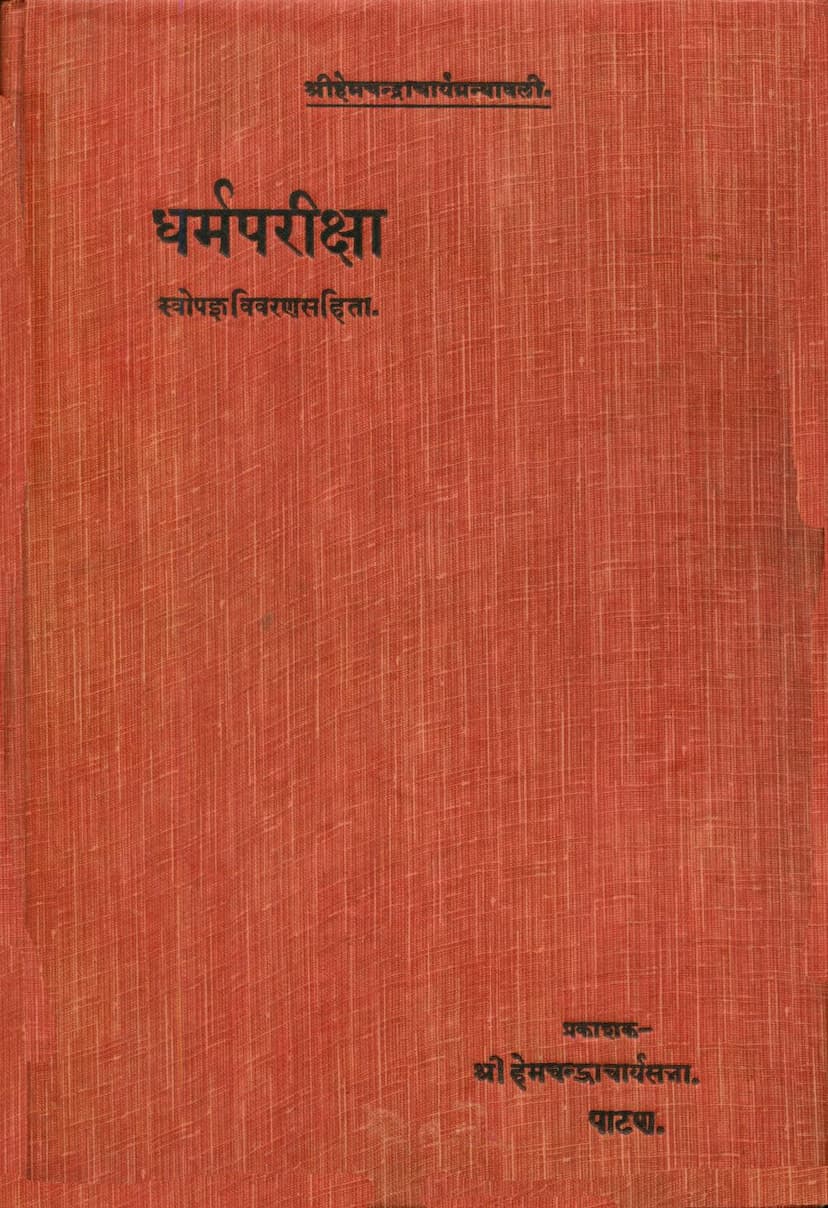Dharm Pariksha
Added to library: September 1, 2025

Summary
Here's a comprehensive summary of the Jain text "Dharm Pariksha" by Bhagwandas Pandit, based on the provided catalog link and content:
Dharm Pariksha: A Comprehensive Examination of Dharma
"Dharm Pariksha" (धर्मपरीक्षा), authored by Bhagwandas Pandit and published by Shri Hemchandracharya Sabha, is a significant Jain text that meticulously examines the nature and principles of true Dharma. The work, enriched with a self-commentary (स्वोपज्ञ विवरणसहिता), aims to clarify any doubts or misconceptions that may arise in the minds of seekers, especially in the current era of spiritual decline (दुःषमाकाल).
Core Purpose and Methodology:
The central purpose of "Dharm Pariksha" is to provide a thorough and reasoned analysis of Dharma, distinguishing it from non-Dharma (उन्मार्ग) and false paths. The author emphasizes the importance of impartiality (माध्यस्थ) as the foundation for examining Dharma. This impartiality, free from attachment (राग) or aversion (द्वेष) towards any particular viewpoint, allows for a dispassionate evaluation of different doctrines and practices. The text advocates for a balanced approach, drawing upon both scriptural authority (आगम) and logical reasoning (युक्ति), ensuring that its conclusions are consistent with the established Jain tradition (गुरुपरिपाटीशुद्धम्) and free from subjective bias (स्वकपोलकल्पनाशङ्का).
Key Themes and Arguments:
The book delves into several critical aspects of Dharma and spiritual practice:
- The Nature of Dharma: Dharma is defined as that which sustains the soul in the cycle of transmigration (भवार्णव). It is presented as a path of liberation, not merely a set of rituals or external observances.
- The Importance of Impartiality (माध्यस्थ): The text strongly advocates for a balanced and objective approach to understanding Dharma. It criticizes partisan adherence to any doctrine without proper scrutiny.
- The Dangers of Deviation (उत्सूत्र and उन्मार्ग): The book critically examines various forms of deviation from the true path, including speaking against scriptural injunctions (उत्सूत्रभाषण) and embracing wrong views or practices (उन्मार्ग). It argues that such deviations, regardless of intention or whether they stem from ignorance or deliberate malice, can lead to an endless cycle of suffering (अनन्तसंसार).
- The Role of Conduct and Knowledge: "Dharm Pariksha" explores the intricate relationship between knowledge (ज्ञान) and conduct (चारित्र). It presents a detailed analysis of the fourfold classification (चतुर्भङ्गी) of individuals based on their adherence to knowledge and conduct, categorizing them as devoted (आराधक) or erring (विराधक) in different degrees.
- The Nature of Misconceptions (मिथ्यात्व): A significant portion of the text is dedicated to dissecting various types of false beliefs (मिथ्यात्व), including those that are habitual (आभिग्रहिक), accidental (अनाभिग्रहिक), dogmatic (आभिनिवेशिक), doubtful (सांशयिक), and due to ignorance (अनाभोग). The author clarifies the subtle distinctions between these, particularly in relation to the potential for liberation (भव्य) or damnation (अभव्य).
- The Nuances of Spiritual Progress: The text discusses the gradual progress on the spiritual path, highlighting the significance of different stages (गुणस्थान) and the development of right perspective (योगदृष्टि). It addresses the subtle differences in how individuals, even those with strong convictions, might err due to their internal states (आशयभेद).
- Critique of Externalism: While acknowledging the importance of external practices (क्रिया), the text consistently emphasizes that true Dharma lies in the internal disposition and purity of intention (भाव). It critiques those who focus solely on outward rituals without cultivating inner purity, deeming their efforts ultimately futile.
- The Concept of Purity and Liberation: The book links the ultimate liberation (मोक्ष) to the purification of the mind and the eradication of negative karmic propensities (कर्मक्षय). This purification is achieved through a deep understanding of Dharma and consistent spiritual practice, guided by right knowledge and conduct.
- The Ineffectiveness of False Paths: "Dharm Pariksha" systematically refutes various non-Jain philosophical and religious viewpoints that deviate from the true path, demonstrating their logical inconsistencies and ultimately their failure to lead to liberation.
- The Importance of Right Conduct and Association: The text stresses the significance of associating with virtuous and knowledgeable individuals (सत्संग) and following the teachings of enlightened beings (गुरु) and scriptures.
Structure and Content:
The "विषयानुक्रमः" (Table of Contents) reveals a logical progression of arguments. The book begins by establishing the purpose of examining Dharma and defining its characteristics, emphasizing the role of impartiality. It then systematically addresses various viewpoints, refuting misconceptions and establishing the true principles of Jainism. The text delves into the intricacies of karma, the different types of false beliefs, the path of progress, and the criteria for true spiritual attainment. The extensive list of cited scriptures in the catalog indicates a scholarly and well-researched approach.
Overall Significance:
"Dharm Pariksha" serves as a comprehensive guide for spiritual seekers, offering clarity and reasoned arguments to navigate the complexities of Dharma. By emphasizing impartiality, scriptural adherence, and logical reasoning, Bhagwandas Pandit equips readers with the tools to discern the true path and to avoid the pitfalls of misguided beliefs and practices, ultimately guiding them towards spiritual liberation.